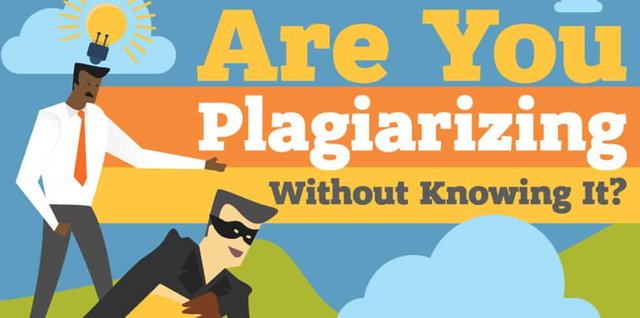Achievement Three: Content Etiquettes by @davidalloy

image source: kunzonpublishing.com
Are you aware that you can Google anything and get an answer within splits of seconds, and you’ll likely find several sources for the information you’re after.
However, many of those sources all found that information somewhere else i.e., from a reputable primary source.
It is wise and also advisable to follow those secondary sources back to the primary source, which could be an academic paper, a study, a news article, even a well-researched opinion piece on a popular blog. It could take some digging in most cases, but it pays off in that;
- The individual gets to know that the data or information quoted is correct.
- The individual also gets to put the content in his or her own words, this avoiding plagiarism.
- If the individual decides to quote, he or she can quote the original text, rather than someone else’s interpretation.
Therefore, the inappropriate copying of someone else's work is Plagiarism.

image source: blogs.egu.eu
Definition:
"Plagiarism is the representation of another
author's language, thoughts, ideas, or expressions as one's own original work. In educational contexts, there are differing definitions of plagiarism depending on the institution. It is considered a violation of
academic integrity and a breach of journalistic ethics . It is subject to sanctions such as penalties, suspension, expulsion from school or work, substantial fines and in since cases, incarceration." Source: wikipedia.

image source: grammarly.com
Types of Plagiarism
Mosiac Plagiarism:
In this type of plagiarism, the work of someone else is simply paraphrased without proper citation, It can be done from one or several sources.
Paraphrasing Plagiarism:
This is the most common type of plagiarism, however, the difference is that the copied work isn’t mixed in with new concepts and research.
Complete Plagiarism:
Complete plagiarism is more common in academic writing than in content marketing or other types of online writing. It occurs when someone tries to submit an entire research paper as their own without proper attribution.
Self Plagiarism:
Also known as auto-plagiarism, it happens when you copy your own writing, whether intentional or not. Some persons think self-plagiarism is harmless because you aren’t stealing from someone else. But, this type of plagiarism can be just as damaging as any other.
Accidental Plagiarism:
Plagiarism doesn’t always happen on purpose. It’s still considered plagiarism when someone copies another’s writing without citing their source, improperly cites the source or leaves out quotation marks on accident. This is why it’s important to check any work and when in doubt, give your source credit.
Source-Based Plagiarism:
This type of plagiarism refers to instances when misleading sources are involved, it could also be when an author quotes a non-existent or incorrect source.
Direct Plagiarism:
This is an intentional and unethical form of stealing content. a word or two might be changed, but this type of plagiarism is too blatant to be considered paraphrasing.

image source: enago.com
How to avoid Plagiarism
Paraphrase:
In this method, one will have to read through the publication and then arrange his or her work in their own words, one should avoid copying verbatim more than two words in a row.
Cite:
This is an effective ways to avoid plagiarism, this entails the addition of the author(s) name and the date of the publication or similar information. It should be done correctly by including a hyperlink to the original page where one found the information, and by including the name of the site or author.
Direct Quoting:
When quoting a source, use the quote correctly, that is exactly the way it appears. It also entails citing the author’s name, the publication the quote came from, and a date of publication, if from the internet, one must include the author or publication name, and also a link to the original source. It must be done correctly to avoid plagiarism allegations.
Referencing:
This is another important way to avoid plagiarism, that is, including a reference page in ones work. The information ii carries must be very specific and should include the author(s), date of publication, title, and source.
The Use of images:
Content with images gets more user engagement than content without images.
According to research on visual content marketing by BuzzSumo, blog posts with images once every 75-100 words received twice the number of shares than articles with fewer images than that.
Originally published at Writecheck

image source: whoishostingthis.com
Note:
When in doubt, use a plagiarism checker, if you’re not sure whether what you’ve written is truly original, it’s a good idea to use an online plagiarism checker. There are several of these available, usually for free.
I am glad to have made this post about Content Etiquette on this Community, i hope this information turns out to be useful.
Here's my link to my Achievement 1 post, to get to know me better: Achievement 1: My Introduction Post to the Newcomers' steemit Community @davidalloy..
All thanks to
@bright-obias,
@cryptokannon,
@steemcurator1,
@steemblog and
@steemcurator3,
for their efforts, support, direction and guidance to members of this great Community
Nice write-up. Plagiarism have no place on Steemit👍
Thank you
You have been upvoted by @bright-obias, Steem Greeter from STEEM POD Project and we are voting with the Steemit Community Curator @steemcurator03 account to support the newcomers coming into steemit. Follow @steemitblog for the latest update on Steem Community. Steem on!
I'm grateful sir